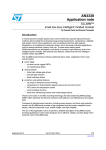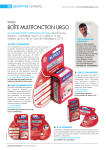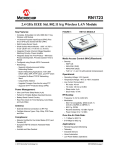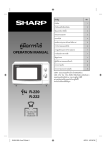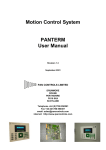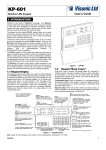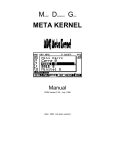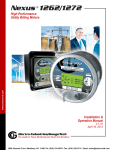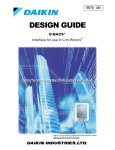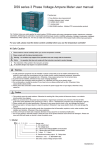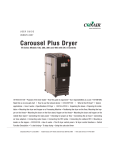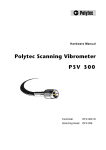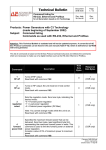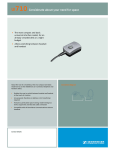Download MatchBox 2 series | User Manual
Transcript
MatchBox 2 series | User Manual 1 Integrated Optics 2 MatchBox 2 series | User Manual &217(176 3 ,1752'8&7,21 6<0%2/6$1'/$%(/6 6$)(7< 2SWLFDO6DIHW\ (OHFWULFDOVDIHW\ (OHFWURPDJQHWLFFRPSDWLELOLW\ '(6&5,37,21$1'63(&,),&$7,216 /DVHU2XWSXW6SHFLILFDWLRQV 0HFKDQLFDO'HVLJQ +HDW0DQDJHPHQW /DVHU2XWSXW2SWLRQV /LQHZLGWK2SWLRQV 2SHUDWLQJ(QYLURQPHQW 813$&.,1* 23(5$7,21 $WWDFKPHQWWRD+HDWVLQN 3RZHUDQG6LJQDO&RQQHFWLRQV 8$57EXV ,QVWDOOLQJ&RQWURO6RIWZDUH /DVHU&RQWURO6RIWZDUH &RPPXQLFDWLRQFRPPDQGWDEOH &RPPXQLFDWLRQZLWKPXOWLSOHODVHUVLQDEXV 0RGXODWLRQ $WWDFKLQJ&RQWURO,QWHUIDFHV $&&(6625,(6 %UHDNRXW3&% Integrated Optics 8$5786%FRQYHUWHUFDEOHSDUWQXPEHU$0&B $GDSWHUWR0SDUWQXPEHU$0+ )RUFHG$LU&RROHUSDUWQXPEHU$0+ 7URXEOHVKRRWLQJ4$ 4 MatchBox 2 series | User Manual INTRODUCTION The ‘MATCHBOX 2 ’ series is a major platform upgrade of market beloved ‘MatchBox’ series, which includes a range of continuous wave laser sources, featuring wide range of wavelength, output power, output type and line-width options. The series is composed of solid state (DPSS) lasers as well as direct laser diode (LD) lasers. Despite the different technical implementation, physical and electrical properties, usability and connectivity are almost identical throughout the series. Therefore Integrated Optics, UAB provides a single user manual for the entire series and emphasis on differences between models is provided wherever necessary. As the title hints, MATCHBOX 2 products are ultra-compact, single-unit laser sources with overall dimensions comparable to a regular matchbox (30x50x16 mm, not taking into account the connector pins). Please take your time to read this instruction manual which provides essential information on the usage of the laser. We have also included various hints and tips that will help you get most from a certain laser source. 5 Integrated Optics 6 MatchBox 2 series | User Manual SYMBOLS AND LABELS Along the text you will find icons designed to draw your attention to different bits of safety or otherwise important information: This icon draws your attention to important information, related to the usage of a laser. This symbol is a warning sign. It marks safety precautions related to optical laser radiation and alerts the operator to the danger of exposure to hazardous visible or invisible laser radiation. This symbol is a warning sign. It marks safety precautions related to electrical safety and alerts the operator to the presence of dangerous voltage, which might appear on certain conditions. Electric shocks caused by such voltage may constitute risk both to the operator and equipment used. Figure 2-1. A label on a side of the laser indicates product safety information. MATCHBOX 2 lasers belong to the class 3B. 7 Integrated Optics Figure 2-2. Serial number is marked on the back of the laser body, right above the connecting pins. 8 MatchBox 2 series | User Manual 3. SAFETY 3.1: Optical Safety Light, emitted from a laser source features hazardous properties, as compared to conventional light sources, such as luminescent bulbs, light emitting diodes, etc. It is important for users, who use a laser system, or other persons approaching to it, to know the dangers involved. Only users, who are familiar with laser safety should use the laser system to minimize the risks of laser radiation-related accidents. MATCHBOX 2 lasers are Class 3B laser products. Different models are arranged to emit up to 500 mW of visible or invisible (infrared) radiation. The radiation is hazardous if the eye is exposed directly to the beam or to specular reflection thereof. The risk of permanent eye damage or even blindness increases with longer exposure times. Diffuse reflections as those from paper or other matte surfaces are typically not harmful if viewed at a distance of 1 m (3 ft) or larger. The use of eye protection when operating the MATCHBOX 2 laser is necessary if at any 9 Integrated Optics circumstances the laser beam could be exposed to eye directly or through a specular reflection. Eye protection in the form of spectacles or goggles with appropriate wavelength filtering is preferred. For example, eyewear absorbing in the spectral region 180 to 532 nm are suitable for working with e.g. 405 nm, 457 nm, 473 nm, 488 nm, 491 nm, 515 nm and 532 nm MATCHBOX 2 lasers, but probably will not suit 561 nm, 593 nm or radiation of the red and infrared regions. Use of protection eyewear provides another significant advantage - when working in dark rooms, laser radiation may haze your eyes even if observed from diffuse reflections. Properly chosen eyewear will reduce or even eliminate such haze and extend productive hours. The beam emitted from Class 3B lasers can easily damage photosensitive surfaces like those found in photodiodes, CCD cameras or photomultipliers. It is important to make sure that an unattenuated beam does not strike any of aforementioned devices directly. Calculation of allowable fluence is necessary before using such devices with our lasers. In addition to laser safety from the laser source alone, following safety precautions must be followed: 10 MatchBox 2 series | User Manual • Experimental setups must ALWAYS be horizontal and below eye level; • To avoid accidental exposure, never bend over or sight down. If something falls down from experimental setup, user must first turn off laser and just then pick up; • Use protective shields or filters to get rid of unnecessary reflections and scattering; • User should never wear jewels, watches while using the laser system to avoid the reflections from surfaces thereof; • The laser system must be used in a closed room, because high power and collimated laser beam can damage biological tissues even at long distances; • Extreme caution must be taken when using volatile substances in laser operational area; • High level of ambient light in laser operating room should be maintained whenever possible, in order to keep the pupil of the eye as small as possible and to prevent the risk of eye damage; • Warning signs must be posted near the entrance to the laser operation area and inside; • Use of laser must be limited to users, who are completely familiar with the rules above. 11 Integrated Optics 3.2: Electrical safety Electrical safety is as important as optical safety. Electric shocks from an unsuitable or poorly grounded power supply, can cause extreme pain, severe burns, cardiac arrest and can even be lethal, that is why the operator should always obey the safety measures below. The laser body of MATCHBOX 2 is connected to the ground - all internal electronics share the same ground of the laser body. User must make sure that the power supply used with MATCHBOX 2 laser has grounded pin connection (preferably a medical type power supply) and is well grounded and that there are no grounding interruptions with other devices, because it can be dangerous for the operator and cause malfunction of the laser. 3.3: Electromagnetic compatibility The European requirements for Electromagnetic Compatibility (EMC) are specified in the EMC Directive (published in 2004/108/EC). Conformance (EMC) is achieved through compliance with the harmonized standards EN55011:2009 for emission and EN61000-61:2007 for immunity. 12 MatchBox 2 series | User Manual The laser meets the emission requirements for Class 3B as specified in EN55011:2009. Compliance of lasers within the MATCHBOX 2 series with the (EMC) requirements is certified by the CE mark. 13 Integrated Optics 14 MatchBox 2 series | User Manual 4. DESCRIPTION AND SPECIFICATIONS 4.1: Laser Output Specifications The MATCHBOX 2 series includes a variety of lasers featuring different wavelength and power ratings. the complete specification of the laser radiation are provided together with a certain laser, which is sold to the Buyer. A detailed specsheet incorporates output power, long-term and short term noise, line-width, beam quality and other useful specifications. 4.2: Mechanical Design The laser sources within the MATCHBOX 2 series employ a single-box design, which means that all optics, power electronics and thermal management components are located within a single enclosure. The overall dimensions of the laser are 30x50x16 mm (WxDxH), not taking into account the connecting pins, which are used for connecting the laser to a power source and control interface. The pins extend approx. 10 mm from the back of the laser. Different output options, such as freespace output with or without a mechanical 15 Integrated Optics shutter, permanently fixed fibers, have different arrangements on the front facet of the laser. Figure 4-1. Top and side view drawing of the MATCHBOX 2 laser, freespace output option. 16 MatchBox 2 series | User Manual Figure 4-2. Top and side view drawing of the MATCHBOX 2 laser, fiber coupled output option. 17 Integrated Optics 4.3: Heat Management The enclosure is made from a black passivated copper, which ensures superior heat dissipation through the sides and the bottom of the enclosure. The main direction for heat dissipation is through the bottom, therefore the enclosure must be mounted on an additional heatsink for proper thermal management. Depending on model, one or two thermo-electric coolers (TEC) are equipped inside the enclosure for thermal management of a pump laser diode and associated optics. Thermal stabilization of all critical components is very important for lownoise and efficient operation of the complete laser. Depending on laser configuration, cooling of 5 to 20 W (at 25 °C ambient temperature) may be required in a form of conduction-cooled or watercooled heatsink, attachable to the bottom side of the laser. Also, depending on model, a suitable heatsink must have low thermal resistance. For DPSS lasers thermal resistance of <0.5 °C/W is recommended, while for diode lasers <1 °C/W is sufficient. <0.5 °C/W requirement is usually met 18 MatchBox 2 series | User Manual by a larger passive copper heat sink or an actively cooled aluminium heat sink. Integrated Optics, UAB offers variety of accessories for thermal management. Please contact us for purchase. For efficient cooling, make sure that there are no other heat radiating devices, such as heat exchangers, heaters or computers in the proximity of the laser. For efficient cooling, make sure that the laser is not covered with or obstructed by any obstacles, which could prevent air circulation around the laser. All MATCHBOX 2 lasers are equipped with internal thermal protection feature. If the internal temperature reaches 40 °C, the laser shuts down or starts to blink. If this happens, turn of the laser and ensure better heat dissipation by decreasing the heat-sink temperature and increasing the heat-dissipation capabilities thereof. 4.4: Laser Output Options MATCHBOX 2 laser sources are offered in two main configurations with respect to the type of output of laser radiation. 19 Integrated Optics Free-space output is commonly used in compact (portable) laser setups, where working area (an object to be irradiated) is relatively close to the laser source and the beam could be delivered directly or using just few mirrors. Furthermore, the free-space output versions can be provided with an aluminium safety cap (not shown in pictures), which might be necessary for a scientific open-frame setup. The cap (as a standard, not provided with the laser) must be attached to the output window, whenever the laser is not in operation or it could be shut for a short period of time, in case minor adjustments need to be made without stopping the laser, thus stable operation is not lost. In all other cases, it is advisable to trigger the interlock function found on all control interfaces of the MATCHBOX 2 laser. 20 MatchBox 2 series | User Manual Figure 4-3. Free-space output version of the MATCHBOX 2 laser. Permanent fiber pigtailed output has few modifications, though it looks essentially similar. The difference is in the fiber type, which is represented by the color of the PVC jacket. Multimode (orange jacket), single-mode (yellow jacket) or single-mode polarization maintaining (blue jacket) fiber could be arranged with this output type. It is readily used in microscopy and diagnostic setups, where few laser sources are placed in a distance from the analytical device, e.g. a microscope, and radiation of several 21 Integrated Optics wavelengths is delivered to the microscope via optical fibers. Lasers with non-detachable fibers feature lower output power, and 2-3 times worse output power stability, as compared to free-space versions. Figure 4-4. Fiber pigtailed output version of the MATCHBOX 2 laser; blue fiber jacket represents a polarization maintaining fiber type. 22 MatchBox 2 series | User Manual 4.5: Line-width Options Most of MATCHBOX 2 lasers are offered in two line-width options - broad and narrow, in other words, featuring respectively multiple longitudinal modes or single-longitudinal mode (SLM). In all cases, the broad line-width option means, that no additional measures were taken to narrow the emission spectrum - it is as radiated by a laser diode (in direct diode lasers) or a gain medium (in DPSS lasers). The narrow line-width option means that special measures were taken in order to force (or filter) radiation of just single longitudinal mode (SLM in DPSS lasers) or just stabilized wavelength and one or just few longitudinal modes (in direct diode lasers). Usually, the SLM version of DPSS MATCHBOX 2 lasers feature line-width of <5 pm or the bandwidth is <50 MHz. 4.6: Operating Environment MATCHBOX 2 lasers are designed to be operated in non-condensing environment, in the temperature range between 15 and 30 °C. Whether the customer needs to operate the laser at higher temperature, such option has to be provided by Integrated Optics, UAB during assembly of the laser. The temperature range 23 Integrated Optics can also be extended by attaching the laser to a cold plate, which has surface temperature in the aforementioned range and good thermal conductivity parameters. Dusty environment might cause collection of debris on an output window of the laser. Therefore special maintenance, such as cleaning of the exterior of the output window must be performed from time to time in order to keep the laser power within the desired power range and extend the lifetime of the laser. 24 MatchBox 2 series | User Manual 5. UNPACKING Every MATCHBOX 2 unit is packed in an antistatic foam package, which is arranged to protect electronics inside the laser from charge accumulation and is absorbing mechanical shocks well during transportation. Further the foam is packed into a carton. Figure 5-1. The package of a MATCHBOX 2 laser. During unpacking, cut the box sticker along the opening edge, but when opening, keep the box in a horizontal position. Typically a package contains: 25 Integrated Optics • one laser source; • one breakout cable for USB and DC power; • 2 pieces of M2.5 hex bolts; • one hex key; • a user manual. Power supplies and bigger accessories, such as heat-sinks or external control interfaces, if provided, are packed separately. 26 MatchBox 2 series | User Manual Figure 5-2. The MATCHBOX 2 laser and its accessories fitted in an antistatic foam inlay. 27 Integrated Optics 28 MatchBox 2 series | User Manual 6. OPERATION 6.1: Attachment to a Heatsink The MATCHBOX 2 series includes DPSS and direct diode lasers, whereas the higher power DPSS lasers tend to generate more excessive heat than the diode lasers. Furthermore, all MATCHBOX 2 lasers are equipped with a TEC (Peltier) thermal management, which, when operated, generates even more heat to stabilize optical cavity and electronics inside the laser, thus it is required to attach the laser enclosure to an external heatsink, such as an aluminium breadboard or a water cooled plate. In case a laser installation does not meet heatsinking requirements, internal thermal protection stops the laser operation whenever the internal temperature reaches around 40 degrees Celsius. As an accessory, Integrated Optics, UAB offers few heat-sinking solutions, including selfsufficient forced air cooler or a breadboard adapter plate (See “ACCESSORIES” on page 53.), which is used to fasten the laser to a 29 Integrated Optics standard 25 mm M6 thread pattern of a standard optical table or breadboard. Thin layer of good conductivity thermal grease must be applied to the interface between the laser and the heatsink. 6.2: Power and Signal Connections All MATCHBOX 2 lasers, are powered from a +5 V DC power supply. Depending on wavelength, output power and temperature of a mounting surface the laser might require up to 5 Amps (25 W) power supply. The OEM version of the MATCHBOX 2 laser comprises a flexible PCB ribbon with 7x2.54mm or 8x2.54mm female pinhead connectors, as depicted in Figure 6-1. 30 MatchBox 2 series | User Manual Figure 6-1. Connecting pins with 2.54 mm spacing on the back side of the laser; pinout. Viewing right to left, the pins are dedicated for: one pin for +Vcc, next two are UART bus interface pins Tx and Rx, then follows a multifunctional pin (TTL modulation or fan speed control). TTL or FAN setting is selected from the laser control software. An empty slot is used as a key, ensuring that the female pinhead connector will not be inserted in a wrong orientation or position. 31 Integrated Optics The fifth pin works as a ground. The ground pin is soldered into the enclosure of the laser, thus complete laser body is grounded. 6.3: UART bus UART (Universal Asynchronous Receiver/ Transmitter) is a commonly used communication device in computer based systems. This form of serial communication is compatible with USB and RS232: • Single message where a master writes data to a slave; • Single message where a master reads data from a slave; • Combined messages, where a master issues at least two reads and/or writes to one or more slaves. 6.4: Installing Control Software Users of MATCHBOX 2 lasers can download a control software from the web directory of Integrated Optics, UAB. For this download please contact us at [email protected] 32 MatchBox 2 series | User Manual In order to install the software, extract installation files from a RAR compressed folders and run the file ‘Setup’. Figure 6-2. Initial installation window. Installation procedure is very short. After that the control program can be launched by finding ‘MatchBox 2 Control’ among installed programs or by searching this in a search field of Windows. 6.5: Laser Control Software The control software incorporates many useful parameter settings and readings. It also displays 33 Integrated Optics operational hours and times the laser has been started. The software window is shown in Figure 6-4. The window comprises 3 columns, which display the most important information about a particular laser. The first column show information about laser settings, the second column show information about actual readings of laser parameters and the third column indicates laser properties, like model, serial number, operating time, etc. The third column also shows a radiation sign whenever the laser radiation is turned on. Figure 6-3. Main software window. There are two versions of the software – User edition (strongly limited functionality) and Integrator edition (less limited functionality). User 34 MatchBox 2 series | User Manual edition allows changing only the optical power. Other parameters are locked. This way the laser is working in its optimum mode, at factory settings. Figure 6-4. Laser control software window when a laser is connected and radiating. After launching the software, connect the laser to the computer. Press ‘Search Device->Find device’. 35 Integrated Optics Figure 6-5. In order to detect the laser and start communication, press ‘Search Device ->Find device’. Figure 6-6. Once the laser is identified, the fields are filled with information. Whether some parameters are changed, they are not saved automatically. This is done intentionally for several reasons. Whether the 36 MatchBox 2 series | User Manual new laser parameters make the laser operate undesirably, the user can always simply disconnect the laser from USB and power supply and connect it again - the old settings will be restored and displayed on the screen. Another reason not to write new parameters in the memory is limited write cycles of the EPROM. Especially if integrators are making their own control software, having for example a slider for power setting, one stroke of such slider might result in hundreds of values saved in the EPROM, reducing its cycle capacity. In order to save newly set parameters in the laser memory, user must press ‘Device functions>Save settings’. 37 Integrated Optics Figure 6-7. In order to save newly set parameters in the laser memory, user must press ‘Device functions->Save settings’. Figure 6-8. ‘Always on top’ setting can be found under ‘Application settings’. Further we will briefly describe particular lines of the software window. 7DEOH([SODQDWLRQVRIVRIWZDUHILHOGV 8VHU (GLWDEOH )LHOG 0HDQLQJ ,/'PD[ 0D[LPXPFXUUHQWIRU WKHODVHU GLRGH 1R 7(&WHPS 7DUJHW WHPSHUDWXUH RI WKH ILUVW 3HOWLHUFRROHU $FFHVV OHYHO 38 MatchBox 2 series | User Manual 7DEOH([SODQDWLRQVRIVRIWZDUHILHOGV )LHOG 0HDQLQJ 8VHU (GLWDEOH 7(&WHPS 7DUJHW WHPSHUDWXUH RI WKH VHFRQG3HOWLHUFRROHU $FFHVV OHYHO 2SWLFDO3RZHU 7DUJHW RSWLFDO SRZHU RI WKH ODVHU&DQEHVHWLQ'$&YDOXHV RUP:LIWKHSRZHUFDOLEUDWLRQ ZDVGRQH $FFHVV /'FXUUHQW DFWXDO/'FXUUHQW 1R 7(& WHPS UHDGLQJV $FWXDO WHPSHUDWXUH RI WKH ILUVW 3HOWLHUFRROHU 1R 7(& WHPS UHDGLQJV $FWXDO WHPSHUDWXUH RI WKH VHFRQG3HOWLHUFRROHU 1R %RG\WHPS 7HPSHUDWXUH RI WKH ODVHU HQFORVXUH 1R $FFHVVOHYHO 8VHU DFFHVV OHYHO EDVLF FRQILJXUDWLRQ ZLGHU FRQILJXUDWLRQ <HV ZLWK SDVVZRUG /DVHU VHOI VWDUW DIWHUSRZHURQ ,I FKHFNHG WKH ODVHU ZLOO VWDUW ZKHQHYHU'&SRZHULVDSSOLHG <HV D 39 OHYHOD 3RZHUFKDQJHLVQRWUHFRPPHQGHGIRU6/0ODVHUVWKLV PLJKWLQIOXHQFHVSHFWUDOSURSHUWLHVRIWKHODVHU Integrated Optics Laser control software will not work if a laser is not connected to a power supply. In the first instance, the laser should be connected to PC via USB cable. Only then the laser should be connected to the power supply using a breakout cable or a breakout PCB. Laser will start emitting light as soon as Start button is pressed. Please make sure that there is no risk of getting the laser radiate to an eye or skin of a person, as outlined in the SAFETY chapter. Before starting the laser, make sure that the cap is taken off of the output window or a fiber connector. After connecting the laser to a PC via USB port, all information that is saved inside the laser will be read and displayed in the computer screen. Information about laser firmware version, serial number, model, operating time and times laser was started will be provided on the right side of the application window. More than one laser can be connected to a computer simultaneously. All connected lasers can be controlled with multiple program windows – one for each laser. Once connected, lasers are detected automatically. If a newly connected 40 MatchBox 2 series | User Manual laser is not found, use a function 'Search Device' in the top bar. The lasers in MATCHBOX 2 series can have either one or two TEC (thermo-electric cooler) elements arranged inside the laser body. One TEC is used for thermal control of a laser diode and another TEC can be used either for VBG (in direct diode lasers) or non-linear crystal (in DPSS lasers with second harmonic generation). Both temperature values will be displayed in the program window. The user can also observe a percentage of TEC capacity, which is being used. If TEC value is near 100% for more than 10 seconds, it means that the laser does not get enough cooling and it heats too much. In such case, the laser will turn off automatically if maximum threshold temperature will be reached. Next to LD current reading, there is an indicator having two values: ACC (Automatic Current Control) and APC (Automatic Power Control). Normally, the laser should be working in ACC mode while it is warming-up and in APC mode after reaching target temperatures on TECs. There is a check box named 'Laser self start after power on'. It can be changed any time laser is connected to a PC. 41 Integrated Optics Default laser parameters will be displayed, once the laser is connected to the computer. In order to save customized parameters, click 'Device Functions -> Save Settings'. In case some parameters have been changed but not saved, default settings can be restored by going to 'Device Functions – Read Settings’. CHANGING OUTPUT POWER In order to change the optical power of a laser, DAC value should be entered. Possible DAC values are from 0 to 4095, however each laser has a pre-set power limit and sometimes maximum optical power value will be lower than 4095 DAC value. If the laser power is calibrated, calibration values are saved in the micro-controller. In such case, the optical power can be entered in mW. Calibration process can be either done in the factory or it could be done by the user. For calibration instructions, please contact our tech support team writing an email to [email protected]. Calibration is also possible for fiber coupled lasers, as well as for a complete turnkey system, e.g. microscope setup. 42 MatchBox 2 series | User Manual 6.6: Communication command table The following commands are used with MATCHBOX 2 series lasers. 7DEOH&RPPXQLFDWLRQFRPPDQGVRI0$7&+%2;ODVHUV 5HWXUQHG YDOXH &RPPDQG )XQFWLRQ $UJXPHQW Hଦ VWDUWVWRSODVHU RU $&.! RU (55! Fଦଦ VHW /' FXUUHQW WR P$ $&.! RU (55! Fଦଦ VHW P: RSWLFDO SRZHU XVLQJ SRO\QRP WDEOH $&.! RU (55! Fଦଦ GLUHFW FXUUHQW VHW WR '$&ELWIXOOUDQJH $&.! RU (55! Fଦଦ VHWRSWLFDOSRZHU'$& LQELWIXOOUDQJH $&.! RU (55! FଦDଦ HQDEOHGLVDEOH DXWRVWDUW DIWHU SRZHU RQ RU $&.! RU (55! 43 Integrated Optics 7DEOH&RPPXQLFDWLRQFRPPDQGVRI0$7&+%2;ODVHUV 5HWXUQHG YDOXH &RPPDQG )XQFWLRQ $UJXPHQW UଦV UHFHLYH VHWWLQJV 5HWXUQHG YDOXHV DUH 6HW 7 >LQWHJHU@ GHJ 6HW 7 >LQWHJHU@ GHJ VHW /' FXUUHQW >LQWHJHU@ P$ VHW 2SWLFDO SRZHU >LQWHJHU@ ELW UDQJH 2SWLFDO SRZHU >IORDW@ P:0D[DOORZHG/' FXUUHQW >LQWHJHU@ P$ $XWRVWDUW HQDEOH >ERROHDQ@DFFHVVOHYHO >LQWHJHU@ QDQ $XWRVWDUW 2)) UଦU UHFHLYH UHDGLQJV 5HWXUQHG YDOXHV DUH YDULRXV SDUDPHWHUV RI WKH ODVHU 17& 17& 17& ERG\ WHPS /' FXUUHQW 7(& ORDG 7(& ORDG/DVHUVWDWXV P$ 2)) 44 MatchBox 2 series | User Manual 7DEOH&RPPXQLFDWLRQFRPPDQGVRI0$7&+%2;ODVHUV 5HWXUQHG YDOXH &RPPDQG )XQFWLRQ $UJXPHQW UଦL VKRZ ODVHU LQIRUPDWLRQ 5HWXUQHG YDOXHV DUH ILUPZDUH YHUVLRQVHULDOQXPEHU SURGXFW FRGH RSHUDWLQJ WLPH /' WXUQRQWLPHV )LUPZDUH IRU 0DWFK%R[,, Y /DVHU 61 /DVHUPRGHO /$ K PLQ WLPHV ,'" UHWXUQ SURGXFW ,' GLJLW YDOXH LV UHWXUQHG ZLWK UDQGRP GHOD\ XS WRPV ! 10" 5HWXUQV ODVHU QDPH WKHSURGXFWFRGH / $! UଦW UHFHLYH RSHUDWLQJ KRXUV 5HWXUQV LQIRUPDWLRQ DERXW RSHUDWLQJ KRXUV DQG KRZ PDQ\ WLPHV WKH ODVHU GLRGH KDV EHHQ VZLWFKHGRQ K PLQ WLPHV UଦS UHFHLYH RSWLFDO SRZHU SROLQRPPHPEHUV 45 Integrated Optics 7DEOH&RPPXQLFDWLRQFRPPDQGVRI0$7&+%2;ODVHUV 5HWXUQHG YDOXH &RPPDQG )XQFWLRQ $UJXPHQW UଦP UHFHLYH RSHUDWLQJ PRGH$3&$&& UଦO UHFHLYHDFFHVVOHYHO $FFHVV OHYHO IଦV VDYHFKDQJHV $&.! RU (55! 6.7: Communication with multiple lasers in a bus There are several ways, how integrators can connect and control multiple lasers in a single communication bus. Our engineers have tested and recommend connecting diagram as depicted in Figure 6-9. 46 MatchBox 2 series | User Manual Figure 6-9. Suggested communication diagram for multiple lasers in a single bus. This communication diagram is based on simultaneous communication from the system UART controller to all connected lasers and 47 Integrated Optics individual response from a particular laser or random timing response from all lasers to the system UART controller. One example of such communication is shown in Figure 6-10, where system UART enquires all lasers in the bus to send their IDs. All lasers respond randomly. Communication from a single laser takes less than 20 ms. Random communication from laser side, in response to general system UART enquiry, raises non zero collision probability, especially when the number of lasers becomes large. In such case collided responses are rejected. The ID request must be repeated. All communication from the laser side features commands with ‘<’ ‘>’ beginning and end symbols. New laser can be connected while others are operating. ID request is repeated in order to collect IDs once again. 48 MatchBox 2 series | User Manual Figure 6-10. ID request sent from system UART to a bus with multiple lasers. 49 Integrated Optics 6.8: Modulation Modulation can be made using UART controller (digital). UART modulation allows to set power with a 12bit resolution and update the power setting with a 6kHz rate. Which means that the laser can be modulated max. 3 kHz at a 50:50 duty cycle. Modulation is possible between any two power levels. For example, between 0 mW and 50 mW or 20 mW and 50 mW, etc. Waveform generation is also possible at a lower repetition rate of ~24 Hz. 6.9: Attaching Control Interfaces The pins of the laser can be attached to control interfaces, which are designed as accessories of the MATCHBOX 2 series. On the other hand, in OEM arrangements, the pins can be connected to a custom electronics within a laser workstation or portable laser equipment, which is arranged to work as a control interface for the laser. Orientation of the pinhead has to be taken in account, when connecting a control interface to the laser. All pins of the laser must connect to corresponding pins in the control interface. 50 MatchBox 2 series | User Manual Wrong connection of the pinhead might lead to permanent damage of the laser electronics. 51 Integrated Optics 52 MatchBox 2 series | User Manual 7. ACCESSORIES MATCHBOX 2 lasers are designed with all necessary power electronics and microcontroller unit placed inside the laser head enclosure. Just control interfaces are attachable to the pins at the end of the laser body. 7.1: Breakout PCB 7.2: UART-USB converter cable (part number: AM-C_) Figure 7-1. UART-USB cable is used for PC communication and DC power. 53 Integrated Optics The UART-USB cable is a breakout cable, having two connectors - DC power connector for +5VDC power input and a regular USB-A male connector, which is used for PC communication. At the laser side the cable has just a single 6 slot pinhead connector. 7.3: Adapter to M6 (part number: AM-H4) The adapter to M6 is a universal mounting plate both for conduction or water cooling. It is made of copper in order to ensure best possible heat dissipation from the bottom surface of a MATCHBOX 2 laser to a larger mounting surface, such as an optical breadboard, etc. Figure 7-2. A laser mounted onto the adapter. 54 MatchBox 2 series | User Manual Figure 7-3. Several lasers mounted on adapters to M6; such arrangement is space saving. The adapter set comprises two standard M6 bolts and a small syringe of thermal grease. The adapter plate comprises two connectors for water cooling. The adapter to M6 does not dissipate the excessive heat from a laser itself, it just transfers the heat to a larger surface or to into water for heat dissipation. Always apply a thermal grease to both surfaces of the adapter. The layer of thermal grease shall be as thin as possible, but it should cover the interfaces between a laser and the adapter and 55 Integrated Optics between the adapter and an optical breadboard homogeneously. 7.4: Forced Air Cooler (part number: AM-H3) An actively air-cooled heat-sink is made of anodized aluminium. It incorporates a 5V fan and threaded holes for fastening of a MATCHBOX 2 laser in two different orientations and other optomechanics holders. Figure 7-4. MATCHBOX 2 laser mounted on the forced air cooler. 56 MatchBox 2 series | User Manual The forced air cooler is arranged with the fan wires coupled into a pinhead connector such that it could be connected to the corresponding pins of a breakout PCB, in order to provide +5VDC power. Always apply a thermal grease to the interface between the laser and the cooler surface. The layer of thermal grease shall be as thin as possible, but it should cover the complete interface area of the laser. All threaded holes in the forced air cooler comprise an M2.5 thread, therefore M2.5 bolts shall be used for attaching the MATCHBOX 2 laser. 57 Integrated Optics Figure 7-5. The forced air cooler is fastened to a standard 1/2” post. 58 MatchBox 2 series | User Manual Figure 7-6. The forced air cooler is fastened to two standard 1/2” posts and the laser is in upside down orientation. Such fastening is good for best performance of the forced air cooler and fairly good mechanical stability. For most efficient functioning of the forced air cooler it should be arranged in an open space. The heat-sink protrusions form multiple air channels and upon operation of the fan, directional airflows are formed inside those channels, providing efficient heat dissipation. 59 Integrated Optics The fan can be connected in two ways. In one polarity it sucks air from below and blows it towards the protective grill. In another polarity it blows the air into the aluminium mounting plate. The second way of operating the fan has a disadvantage that heated air is blown in front of the laser output. Created turbulences can cause distortions of the beam profile and affect beam pointing stability. If this is sensitive to an application, make sure that the polarity of the fan is selected such that the fan blows the air towards the protective grill. 60 MatchBox 2 series | User Manual 8. TROUBLESHOOTING Q&A Whether there are any technical issues concerning our products or any general questions, we are always willing to answer it as fast as possible via email or phone. In order to save both our and our clients time, we have provided a list of frequently asked questions. Frequently Asked Questions: • Q: What type of power supply should I use? A: It should be 5V output power and 5A max output current for DPSS lasers and 3A output for diode lasers. We highly recommend to use the same power supply as we offer on our website. Otherwise we cannot ensure that the laser would work the same as it was tested during production. • Q: Power has dropped drastically. What happened? A: Please check if heat dissipation is sufficient. Launch the laser control software, check whether the TEC is not operating at 100% capacity. What is the voltage between +5Vcc and GND pins? It should be not less than 4.9V and not exceed 5.5V. In case the voltage is different, wires might 61 Integrated Optics be too long or too thin or other components are involved that might cause voltage drop/increase. • Q: How to be sure that laser gets enough cooling? A: During production, our lasers are tested on a large aluminium breadboard - this is one example how to dissipate heat. Keep in mind that steel has very poor thermal conductivity, therefore conventional optical tables and breadboards are not suitable for heatsinking of DPSS lasers. Customer should always use thermal grease when mounting the laser. Body temperature of the laser should not exceed about 35°C, and the TEC load should not exceed 80%, with rare exceptions. Diode laser needs no more than 15 W heat dissipation. DPSS lasers usually require more – about 20W to 25W heat dissipation. All diode lasers and majority of DPSS lasers in the MATCHBOX 2 series could work properly attached to our forced air cooler. • Q: What accessories are needed in order to use Matchbox laser? A: The MATCHBOX 2 series is designed for OEM applications. Integrators can install the laser without any other accessories, just by providing 5V power and UART control signals to corresponding pins on the back of the laser. However for quick setup, a breakout PCB or a 62 MatchBox 2 series | User Manual breakout cable is a good help to start the laser and connect it to a PC via USB. Breakout PCB and a standard USB cable is always included in the laser package free of charge. Also power supply and AC power cable are necessary. You should have in mind that power supply should be ordered separately and that power cable is not included in the package with the power supply. • Q: What is the breakout PCB? A: Breakout PCB is a small printed circuit board attachable directly to the pins of the laser. This electronics board features a soldered DC power cable, an SMA modulation signal cable, a fan drive cable. Furthermore it incorporates a UART-to-USB converter chip (SiLabs) and a micro USB socket. • Q: I changed the laser power in the control software, but after restart of the system the new power setting was not saved? A: New parameters are not saved in the microcontroller of the laser unless ‘Device functions -> Save settings’ is activated. This is done to save EPROM write resource. • Q: What is fiber core diameter? A: We use fibers from many different vendors. Whether you need to know the actual fiber details, please contact us in order to get detailed in63 Integrated Optics formation, such as core diameter or NA of the fiber. • Q: When do I have to use FC/PC and FC/ APC fiber connector? A: We recommend to use FC/APC for SLM lasers - this is to avoid back-reflections from a polished fiber tip to the laser cavity. In all other cases both FC/PC or FC/APC connectors can be used, depending on users preference. • Q: Should I ensure grounding for the laser? A: We recommend that the laser would be mounted to a breadboard which is properly grounded. Electrical socket where power supply is connected must be grounded too. We sell power supplies having grounded pin only. • Q: Can I modulate the laser with PWM square wave? A: Yes. It could be modulated using computer control, by sending commands over the UART interface. • Q: Do I get a replacement if the laser is broken? A: Lasers within warranty period are repaired or replaced free-of-charge. Warranty becomes absolete in cases indicated in the chapter ‘Warranty’. 64 MatchBox 2 series | User Manual • Q: I have ordered an SLM laser, but can observe more than one longitudinal mode. How can I solve this problem? A: It is possible that laser is working at non-optimal temperature point. First step is to make sure if the laser gets enough heat dissipation. Second step is to adjust laser diode (or cavity) temperature using the laser control software. For this access level 2 is needed. Please contact Integrated Optics, UAB for further instructions. • Q: Laser is working, but it's body is very hot. A: First of all it means that laser diode should be fine, but it could be that heat dissipation is not sufficient. You should check how much Amperes does the laser consume. It should be no more than 1,5A for diode lasers and no more 4A for DPSS lasers. • Q: Laser emits no light at all. Power is 0mW. A: First of all it could mean that safety fuse has blown down. The fuse can be replaced only at the factory. Secondly, internal coldplate of the laser is more than 45 C temperature. Third option is that laser fiber could be not fully straightened up or even damaged. You should check for any damages on the fiber itself or its connector. 65 Integrated Optics Recommendations: Before turning the laser on, proper cooling of the laser should be ensured. Laser should be mounted using thermal grease and the screws that were provided with the laser. Please make sure that thermal grease is put very evenly and covers whole bottom of the laser. If laser is fiber coupled, the fiber should be carefully straightened up first. 66 MatchBox 2 series | User Manual WARRANTY Integrated Optics, UAB warrants the MATCHBOX 2 laser to the original purchaser (the Buyer) only, that the laser system, that is the subject of this sale, (a) conforms to specifications provided before a certain laser has been shipped to the buyer and (b) is free from defects in materials and workmanship. The MATCHBOX 2 lasers are warranted to conform to Integrated Optics, UAB published specifications and to be free from defects in materials and workmanship for a period of: • 12 months or 5000 hours of operation, whichever occurs first, for blue and UV range (300 nm to 500 nm) direct diode lasers. • 12 months or 1000 hours of operation, whichever occurs first, for red range (633 nm to 660 nm) direct diode lasers. • 12 months with unlimited operational hours for the rest of the series. The Buyer is responsible for providing the appropriate utilities and an operating environment as outlined in the product literature. Damage to the laser system caused by failure of the buyer's utilities or failure to maintain an 67 Integrated Optics appropriate operating environment, is solely the responsibility of the buyer and is specifically excluded from any warranty, warranty extension, or service agreement. The Buyer is responsible for prompt notification to Integrated Optics, UAB of any claims made under warranty. In no event will Integrated Optics, UAB be responsible for warranty claims made later than seven (7) days after the expiration of warranty. LIMITATIONS OF WARRANTY The foregoing warranty shall not apply to defects resulting from: • Components and accessories manufactured by companies, other than Integrated Optics, UAB, which have separate warranties, • Improper or inadequate maintenance by the buyer, • Buyer-supplied interfacing, • Operation outside the specifications of the product, • environmental Unauthorized modification or misuse, 68 MatchBox 2 series | User Manual • Improper site preparation and maintenance, or • Opening the laser housing. THIS WARRANTY IS EXCLUSIVE IN LIEU OF ALL OTHER WARRANTIES, WHETHER WRITTEN, ORAL OR IMPLIED, AND DOES NOT COVER INCIDENTAL OR CONSEQUENTIAL LOSS. Integrated Optics, UAB SPECIFICALLY DISCLAIMS THE IMPLIED WARRANTIES OF MERCHANTABILITY AND FITNESS FOR A PARTICULAR PURPOSE. 69 Integrated Optics 70 MatchBox 2 series | User Manual 71 Integrated Optics 72 MatchBox 2 series | User Manual 73 Integrated Optics 74










































































